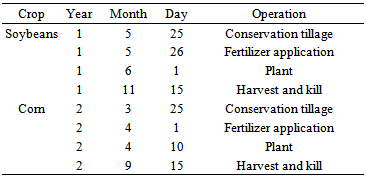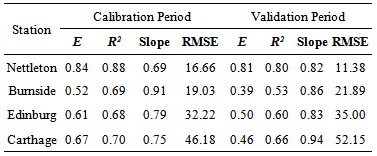-
Paper Information
- Previous Paper
- Paper Submission
-
Journal Information
- About This Journal
- Editorial Board
- Current Issue
- Archive
- Author Guidelines
- Contact Us
American Journal of Environmental Engineering
p-ISSN: 2166-4633 e-ISSN: 2166-465X
2014; 4(3): 46-55
doi:10.5923/j.ajee.20140403.02
Simulating Soil Moisture Content Variability and Bio-energy Crop Yields Using a Hydrological Model
Sarah E. Duffy 1, Prem B. Parajuli 2
1Agricultural and Biological Engineering, Mississippi State University, Mississippi State, 39762, USA
2Department and Biological Engineering, Mississippi State University, Mississippi State, 39762, USA
Correspondence to: Prem B. Parajuli , Department and Biological Engineering, Mississippi State University, Mississippi State, 39762, USA.
| Email: |  |
Copyright © 2014 Scientific & Academic Publishing. All Rights Reserved.
Bioenergy crops can be grown in marginal lands maintaining optimum hydro-environmental conditions such as soil moisture content and they are considered one of the renewable energy sources for the future biofuel needs. The objectives of this study were to evaluate average soil moisture content (SMC) and crop yields from the agricultural fields using the Soil and Water Assessment Tool (SWAT). This study was conducted in the Town Creek watershed (TCW) and Upper Pearl River watershed (UPRW). The SWAT model was reasonably calibrated and validated (coefficient of determination - R2 from 0.53 to 0.88, Nash-Sutcliffe Efficiency Index - E from 0.46 to 0.84, Root mean square error - RMSE from 46.18 to 11.38) using monthly stream flow data. The model predicted soil moisture content results determined statistically no significance difference (p values of 0.2733 for field 2, and 0.3364 for field 3) from two fields and significance difference (p values of 0.0015 for field 1, and 0.0008 for field 4) from other two fields within the watersheds. The SWAT model reasonably simulated (R2 from 0.29 to 0.66, E from -0.26 to 0.63) long-term county level corn and soybean yields from the TCW. Model predicted average corn and soybean yield results showed that TCW can produce 3.74 Mg/ha of corn and 1.53 Mg/ha of soybean yields annually. The results of this study could provide valuable resource information to land managers and policy makers.
Keywords: Soil moisture content, Spatial variability, Stream flow, Crop yield, Model
Cite this paper: Sarah E. Duffy , Prem B. Parajuli , Simulating Soil Moisture Content Variability and Bio-energy Crop Yields Using a Hydrological Model, American Journal of Environmental Engineering, Vol. 4 No. 3, 2014, pp. 46-55. doi: 10.5923/j.ajee.20140403.02.
Article Outline
1. Introduction
- Every person on the planet lives in a watershed and therefore affects its physical condition. Watersheds vary in shape, area, and characteristics but all watersheds are important to the water cycle. Watersheds are often threatened due to point and non-point source pollutions, drought, and water management conditions. Watershed modeling helps to quantify and define the relationship between land use activities and water quality processes in a convenient and economical way [1, 2]. Hydrologic models integrate information from a wide range of sources into easily-applied decision aids [3]. Furthermore, as [4] point out, “hydrologic models…can be useful to extrapolate estimates of land surface fluxes beyond the resolution of point measurements, provided the land surface characteristics are properly represented in the model”. Using geographic information system (GIS) technology, the accuracy of the models can be vastly improved to account for unique site characteristics that may affect how a particular watershed responds to the activities that are occurring within its boundaries.There are a myriad of models available today which are capable of simulating the watershed-scale hydrologic processes and yield. Each model has associated proficiencies and limitations, and often the needs of the study dictate which model is most applicable. For this study the Soil and Water Assessment Tool (SWAT) [5] was chosen due to its ability to simulate a broad array of cropping systems and generate reliable estimates of crop yields, and also its ability to estimate the hydrologic response to different cropping and management systems. Crop growth is predominately determined by calculating leaf area development, light interception, and its conversion into biomass. It also considers the accumulation of heat units and once the crop has surpassed the cumulative heat unit required to reach the maturity, growth of the crop ceases [2]. The SWAT can also simulate plant stress that occurs as a result of water, climate, and nutrients. For each time step potential crop yield is first estimated by the defining factors, such as climatic data, crop characteristics, and phenology. The potential is then reduced due to limiting or stress factors, such as water and nutrients. Finally, the actual yield is a result of any reducing factors such as diseases or pollutants. SWAT predicts both biomass yield and yield using the harvest index of the crop, which is defined as the fraction of above ground biomass removal at harvest [2]. The SWAT has gained international acceptance as a robust interdisciplinary watershed modeling tool able to adeptly predict both hydrology and yield [6]. The SWAT has been used for a wide range of environmental conditions, watershed scales, and scenario analyses as described by [6]. The objectives of this study were to: (a) simulate stream flow and soil moisture content variability and (b) quantify corn and soybean yields from the watershed. The models developed from this study can be applied to future studies to assess environmental responses to changes in land use management.
2. Materials and Methods
2.1. Study Area
- This study was conducted in two watersheds located in central Mississippi: Town Creek watershed (TCW; 1,775 km2) and a portion of the Upper Pearl River watershed (UPRW; 3,609 km2). The majority of TCW lies within Lee, Union, and Pontotoc counties with smaller portions in Chickasaw, Monroe and Itawamba counties (Fig. 1a). Long-term (1990–2009) records of climate data from Tupelo [7] indicate that that mean annual precipitation is 154 cm with average monthly temperatures reaching a minimum of -19°C in December and a maximum of 42°C in August with a mean annual temperature of 16.3°C. The TCW is primarily designated as cropland [8] with the major water system of Town Creek [9]. The UPRW is located mainly within ten counties (Attala, Choctaw, Kemper, Leake, Madison, Neshoba, Newton, Noxubee, Scott, and Winston) as shown in the Fig. 1b. Long-term climate records (1981–2010) from Carthage [7] indicate that the mean annual precipitation is 142 cm with average monthly temperatures of 17.7°C. The headwaters of the Pearl River begin in the area of the Nanih Waiya Indian mounds and drains in the Ross Barnett Reservoir [10].
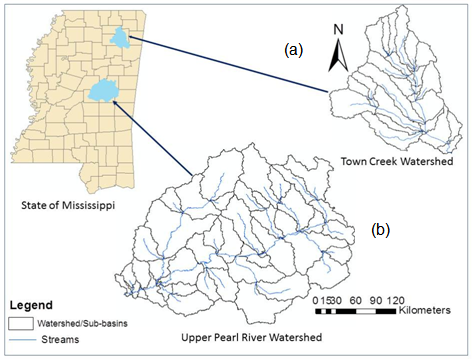 | Figure 1. Location of the (a) Town Creek and (b) Upper Pearl River watersheds |
|
2.2. SWAT Model Description
- The SWAT was developed in the 1990s by the U.S. Department of Agriculture (USDA) Agricultural Resource Service (ARS) and is based on several other ARS models that were already available [11, 6]. Since its inception the SWAT model has continued to be improved and updated in accordance with advances in knowledge and remains actively supported by the USDA ARS [11]. The SWAT has been used to simulate watersheds around the globe, most often being chosen due to its robust capability to quantify the effects of land management practices on hydrological processes, water quality, and crop growth [5]. There are several versions of the software freely available to the public; ArcSWAT, a version of the SWAT2005 model, interfaced with ArcGIS 9.3 was used in this study. The hydrologic component of the model calculates a soil water balance at each time step based on daily amounts of precipitation, runoff, evapotranspiration, percolation, and base flow. The water balance equation is presented in Eqn. (1) [5, 11].
 | (1) |
2.3. Model Input
- As a physically based hydrological model, SWAT requires multiple sets of GIS data to create data layers to input in the model which control the hydrologic processes in the watershed. Key input datasets include topography, soils data, land use/land cover data, climate data, and management data. U.S. Geological Survey (USGS) 30 meter by 30 meter grids digital elevation model (DEM) data were downloaded and used to delineate watershed boundaries, derive stream networks, and determine slope. The DEM information is a seamless product updated bi-monthly and is a part of the National Elevation Dataset which is derived mainly from 10 meter to 30 meter high resolution, best quality digital elevation data covering the United States, Puerto Rico, and the Virgin Islands [14]. The medium resolution (1:250,000 scale) U.S. General Soil Map (STATSGO) (formerly known as the State Soil Geographic Database) [15] was used to create a soil database for both watersheds. Land use data was obtained from the USDA National Agricultural Statistics Service (NASS). The NASS Cropland Data Layer (CDL) is a raster, geo-referenced, crop-specific land cover data layer with a ground resolution of 56 meters and has 254 recognized land use or land cover categories [16]. Use of this data led to a breakdown of approximately 42 percent forest, 14 percent soybean (annual rotation), and 44 percent other covers in TCW and approximately 69 percent forested, 20 percent pasture, and 11 percent other covers in the UPRW.The climatic data inputs required by SWAT are precipitation, maximum and minimum temperature, solar radiation, relative humidity, and wind speed. Daily precipitation, daily maximum temperature, and daily minimum temperature data were obtained from the National Climatic Data Center (NCDC) [7] cooperative weather network. Solar radiation, relative humidity and wind speed data, along with any missing observed data, was generated within the SWAT program using the WXGEN weather generator model [17]. This weather generator was developed for the contiguous United States and used for the SWAT simulation studies [11]. Within TCW three weather stations located in Tupelo, Pontotoc, and Verona were used [7]. The SWAT model also used data from the Booneville weather station (part of the U.S. database); this station is located approximately 20 kilometers north of the watershed. The climatic data inputs for the UPRW were obtained from eight weather stations located in Ackerman, Canton, Carthage, Forest, Kosciusko, Louisville, Newton, and Philadelphia [7]. Daily precipitation data for the UPRW were used from all eight weather stations while the daily temperature data were used from only six weather stations (Carthage, Forest, Kosciusko, Louisville, Newton and Philadelphia). The SWAT model used U.S. database data from six weather stations (State College, Russell, Forest Post Office, Meridian, Winona and Canton). The Forest Post Office weather station is located inside the watershed, whereas the other five weather stations are located from 8 to 40 kilometers away from the watershed. Weather station information was assigned to the each sub-watershed based on the proximity of the available stations to the centroid of the sub-watershed [11]. Based on the unique combinations of the input data referenced above, SWAT identified 1,498 distinct HRUs in 31 sub-basins in TCW and 1,916 HRUs in 45 sub-basins in the UPRW. Corn and soybean management data was also input in the TCW model based on information obtained directly from the landowners of the two study fields. Parameters included crop rotation, planting date, harvesting date, tillage operations, and irrigation and fertilizer amount and application dates. It should be noted that the possible sources of errors in model simulated results may come from the model parameters, GIS data used in developing model inputs such as DEM, land use, soils, and weather. Errors due to measured weather data, especially rainfall and temperature, can significantly influence on model results [18, 2].
2.4. Model Calibration, Validation and Evaluation
- Model performance was evaluated using three commonly used statistical evaluation techniques: the Nash–sutcliffe efficiency index (E), the coefficient of determination (R2), and root mean square error (RMSE) as described by previous studies [19, 19, 20]. Statistical Analysis System (SAS) 9.2 software was further used in some instances to test p-values, and standard correlation calculations.
2.4.1. Stream Flow
- Simulation of the hydrologic balance is usually the first step for all the SWAT watershed applications [6]. Due to the unavailability of field-specific high‐quality input data and theoretical interpretation of hydrological processes, models are calibrated and validated to increase the model’s ability to accurately represent the watershed characteristics [21, 2]. Although the SWAT model was able to perform well in un-gauged watersheds, hydrological calibration and validation was performed using observed stream flow data. Continuous observed mean monthly stream flow data was utilized from the four USGS gage stations (Nettleton- USGS 02436500 in the TCW and Burnside-USGS 2481880, Edinburg-USGS 02482000, and Carthage-USGS 02482550 in the UPRW) in this study. In this study an un-calibrated, baseline simulation was performed first using SWAT default values for hydrologic parameters. After comparing the baseline model to observed USGS streamflow data, calibration and validation for both watersheds was performed by manually adjusting critical parameter values until maximum model efficiency was achieved when the USGS flow values were compared to model-predicted values at the same location. Manual adjustment of sensitive parameters has been suggested to be the preferred methodology for model calibration [22]. Six widely used flow calibration parameters (Table 2) were selected based on previous studies [6, 23, 24, 18]. The first nine parameters collectively represent the curve number (CN) parameter used for land uses (Table 2). The remaining five parameters in Table 2, are soil evaporation compensation factor (ESCO), base flow alpha factor (ALPHA_BF), surface runoff lag coefficient (SURLAG), ground water ‘revap’ coefficient (GW_REVAP) and threshold depth of water in the shallow aquifer (GWQMIN). The calibration ranges of these parameters were also previously described [20].
|
2.4.2. Soil Moisture Content
- The calibrated and validated model was further used to evaluate the ability of SWAT to predict daily SMC. Observed field data collected at 12 points at four field locations were averaged to yield one value at the 6 inch depth for each sampling date. The SWAT model was run at a daily time step from January 1, 2009 to March 31, 2012 separately for both watersheds, the year 2009 serving as a model warm-up period. Model predicted percent moisture content values were calculated by dividing the predicted SMC value (given in millimeters) by the total length of the soil column (also given in millimeters) and then multiplied by 100. Baseline results were achieved using the previously calibrated models and no further adjustment to parameters was done.
2.4.3. Crop Yield
- Observed crop yield data was only used in the TCW. Corn and soybeans were the two crops considered based on those being the primary crops within TCW and the crops grown at the two field locations in TCW. County level corn and soybean yield statistics from 1988-2011 were obtained from [25] for the three primary counties that the watershed spans (Lee, Union, and Pontotoc). County level data for corn and soybean yield were weighted by the watershed area in each county to determine watershed scale crop yield. Input parameters that are considered to be most sensitive for predicting biomass or crop yield includes radiation-use efficiency (Bio_E), harvest index (HVSTI), and maximum leaf area index (BLAI) as recommended by previous literatures [26, 2]. The Bio_E, HVSTI and BLAI were adjusted to produce maximum model efficiency when compared with annual NASS yield data. The parameters and their subsequent values are summarized in Table 3.
|
|
3. Results and Discussion
3.1. Stream Flow
- Four sub-watershed outlets were chosen to calibrate and validate model for predicting monthly streamflow: Nettleton in the TCW and Burnside, Edinburg, and Carthage in the UPRW. These outlets corresponded to locations where USGS gage stations were located. Observed monthly streamflow data were compared to model predicted monthly streamflow outputs. Streamflow was calibrated by manually adjusting critical parameters to improve model efficiency in accordance with the classification established [19]. The TCW demonstrated very good performance for both the model calibration and validation periods (Table 5, Figure 2). Burnside, Edinburg, and Carthage are considered to have shown good performance during calibration. Edinburg maintained good performance during validation while Burnside and Carthage were only fair during validation (Table 6, Figure 2). Likewise, RMSE values demonstrated minimum average error for both the calibration and validation periods for both watersheds (Table 5).
|
|
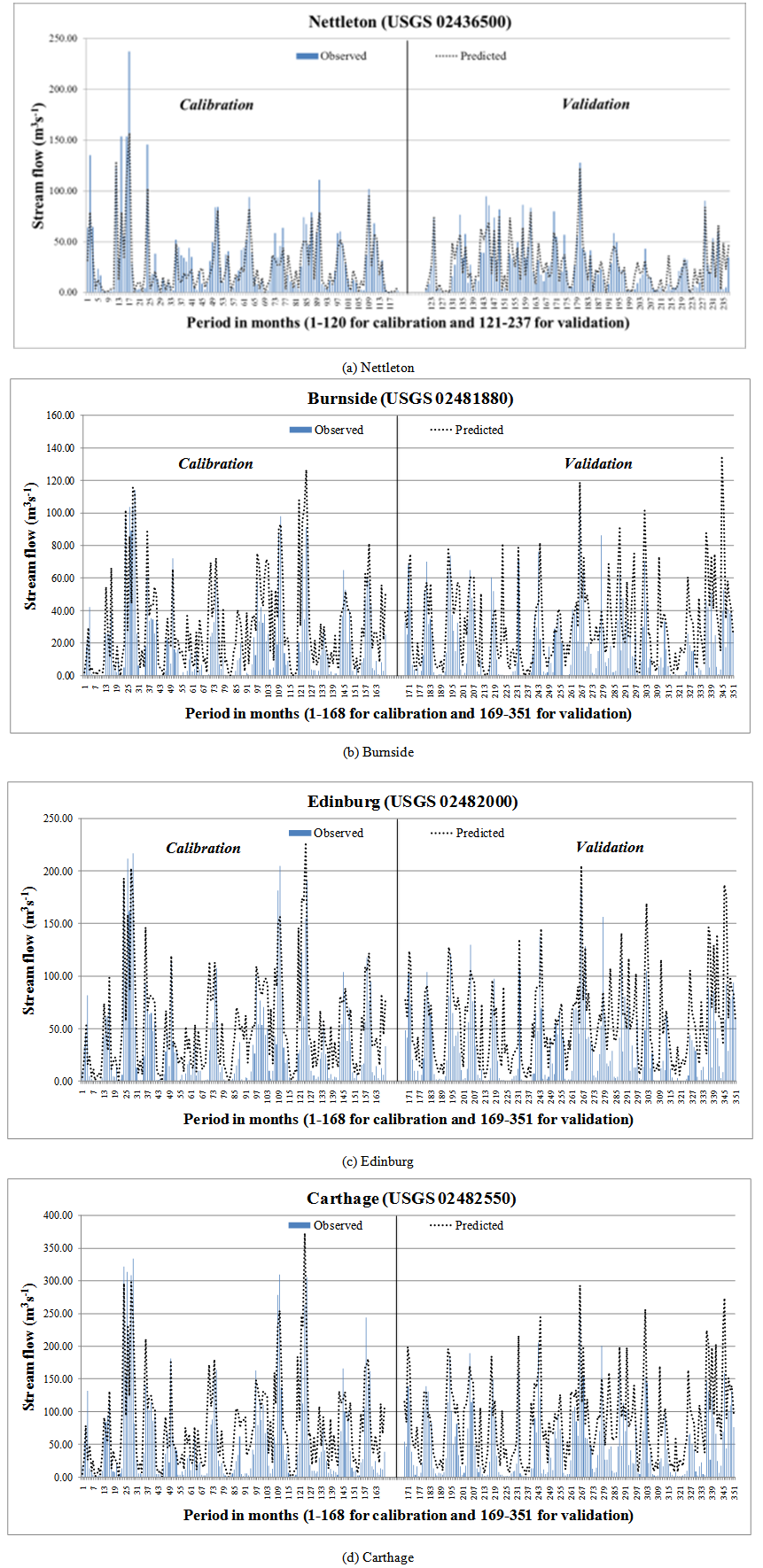 | Figure 2. Observed vs. Simulated Monthly Stream Flow  during Calibration and Validation in the TCW (a) and the UPRW (b, c, and d) during Calibration and Validation in the TCW (a) and the UPRW (b, c, and d) |
3.2. Soil Moisture Content
- Model simulated daily SMC values from the sub-basin were compared with the field observed SMC values from the field where the sub-basin is located. In all four fields it was determined that the model closely follows a similar curve to observed values, although SMC predictions were consistently under predicted, especially in Fields 1 and 4. Results from a t-test comparing data for Fields 2 and 3 showed no significant difference between observed and predicted values (p = 0.2733 and p = 0.3364 respectively). However, Fields 1 and 4 showed statistically significant under prediction when compared to observed values (p = 0.0015 and p = 0.0008 respectively). Table 6 shows the breakdown of the daily data for observed (Obs) and predicted values for all fields.In the following graphical representation (Figure 3), the bars on the primary axis represent the daily observed (blue) discrete and predicted (red) daily mean SMC values. Cumulative monthly precipitation (green) is shown on the secondary axis and is given in millimeters. Model predictions were calculated using the baseline calibration and validation parameter values discussed previously. The model clearly demonstrated a similar trend with observed values and more data (at either the daily or monthly time scale) is needed to verify the accuracy of the observed values.
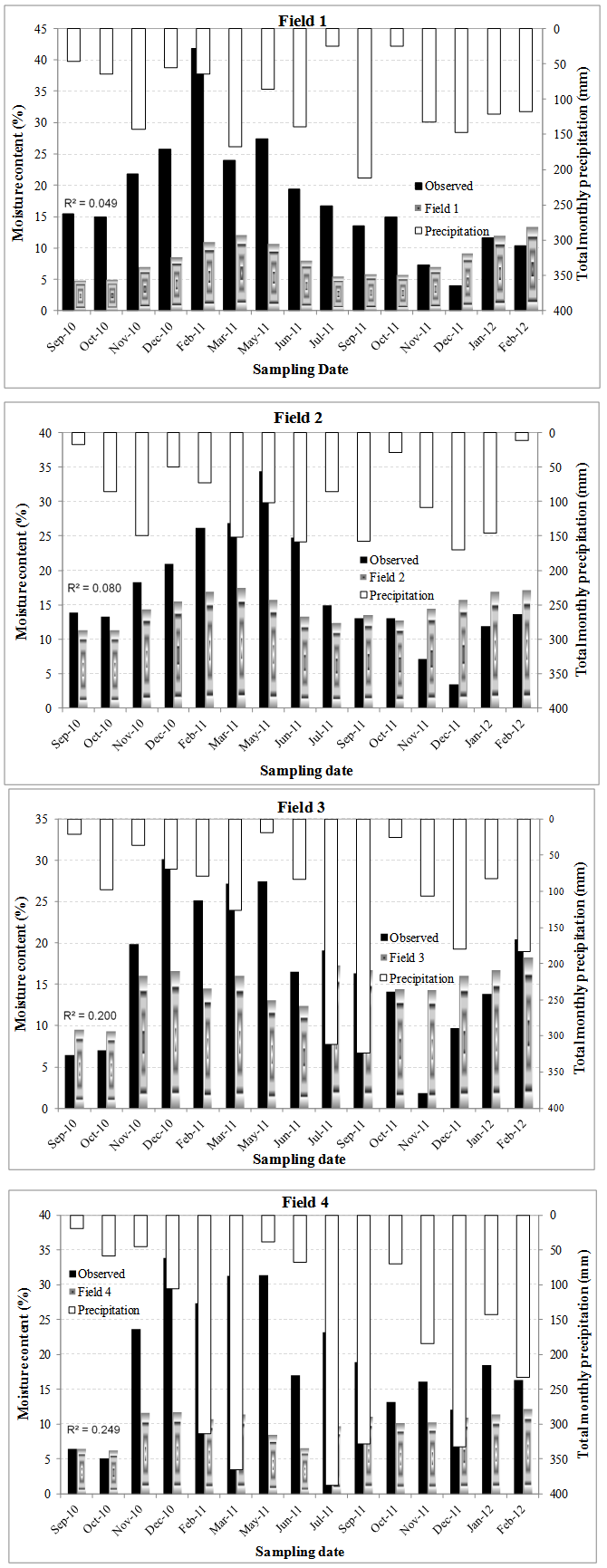 | Figure 3. Observed vs. Predicted Soil Moisture Content (%) from September, 2010 to February, 2012 for fields 1 to 4 |
3.3. Crop Yields
- The crop component of this study was performed in the TCW only. The simulated crop yield for corn and soybeans was compared to the county-reported data collected by NASS and to observed data collected from the landowners at the site locations. Simulated crop yield was compared to the county-reported data collected by NASS from 1989-2011 for corn and 1988-2011 for soybeans. When compared with NASS data, SWAT did a reasonable job of replicating annual yields with good statistics (Figure 4) in the TCW (Fig. 1a). Furthermore, E and R2values for both corn and soybeans were within acceptable ranges as reported by previous literature [27, 2] during the model calibration and validation periods for corn and soybean (Table 7).
|
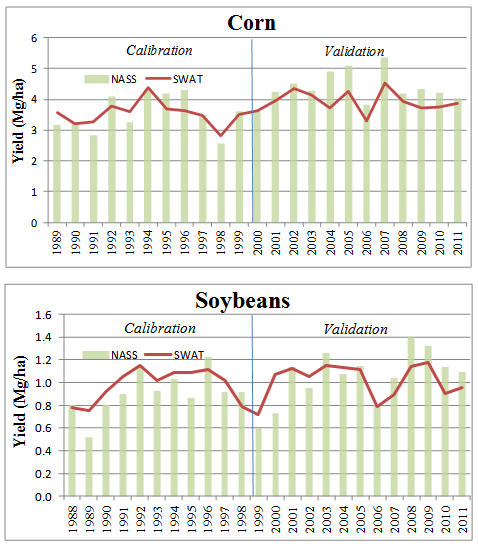 | Figure 4. SWAT (simulated) and NASS (reported) Crop Yield (Mg/ha) for Corn and Soybeans in the TCW |
 | Figure 5. Reported and simulated crop yield for soybeans in Field 2 as well as NASS annual average yield for Lee County, Mississippi for reference |
4. Conclusions
- The purpose of this study was to evaluate hydrologic conditions (stream flows and SMCs) and crop yields from the agricultural fields using the SWAT model. Baseline models were created by inputting required data and delineating the watershed based on topography, soils, and land use. The SWAT model was first calibrated and validated for two agricultural watersheds (TCW and UPRW) using observed monthly stream flow data from USGS gage stations located within the watersheds. Further, model predicted outputs were compared with observed SMCs and crop yields values. Results from monthly stream flow calibration and validation procedure indicated that model performance was within acceptable ranges as documented in the previous literature [6] based on the classification established [19]. The SWAT model outputs indicate that the model under-predicted SMC of the watersheds by about 32% in this study. Calibration and validation of crop yield predictions in the TCW show close replication of variation seen in reported crop yields from NASS. Similarly, although there was limited data, simulated crop yield from the study locations matched closely with yields reported by the landowner. The TCW can produce average of 3.74 Mg/ha of corn and 1.53 Mg/ha of soybean yields annually. The results of this study could provide essential resource information to watershed managers.
ACKNOWLEDGEMENTS
- This material is based upon work performed through the Sustainable Energy Research Center at Mississippi State University and is supported by the Department of Energy under Award Number DE-FG3606GO86025; Micro CHP and Bio-fuel Center. We acknowledge the contributions of Jeffery Hatten in the Dept. of Forestry at Mississippi State University and landowners of the research fields in the watershed for this research.
 Abstract
Abstract Reference
Reference Full-Text PDF
Full-Text PDF Full-text HTML
Full-text HTML


